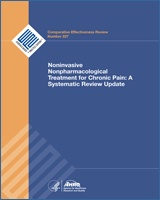From: Results

NCBI Bookshelf. A service of the National Library of Medicine, National Institutes of Health.
| Author, Year, Followup,a Pain Duration, Study Quality | Intervention | Population | Function and Pain Outcomes | Other Outcomes |
|---|---|---|---|---|
Blodt, 2015219 3 and 9 months Duration of pain: Mean 3 years Fair | A. Qigong (movement exercises and exercise to change “qi”) (n=64) 12 sessions over 12 weeks B. Exercise (strengthening, stretching and relaxation exercises) (n=63) | A vs. B Age (mean): 46 vs. 48 years Female: 91% vs. 70% Baseline RDQ: 6.2 vs. 5.7 Baseline pain (0-100 VAS): 55.6 vs. 52.1 | A vs. B 3 months RDQ (0-24): 4.1 vs. 3.1, difference 0.9 (95% CI –0.1 to 2.0) Average low back pain (0-100 VAS): 35.1 vs. 27.4, difference 7.7 (95% CI 0.7 to 14.7) 9 months RDQ: 4.3 vs. 3.1, difference 1.2 (95% CI 0.1 to 2.3) Average low back pain (0-100 VAS): 35.9 vs. 28.8, difference 7.1 (95% CI –1.0 to 15.2) | A vs. B 3 months SF-36 Bodily pain (0-100): 43.0 vs. 44.6, difference 1.5 (95% CI −1.2 to 4.2) SF-36 Physical component score: 45.8 vs. 46.6, difference −0.8 (95% CI –3.4 to 1.9) SF-36 Mental component score: 45.4 vs. 46.6, difference 11.2 (95% CI –4.9 to 2.4) Quality of sleep (0-10): 4.6 vs. 4.5, difference 0.0 (95% CI–0.9 to 1.0) Sleep satisfaction (0-10): 5.0 vs. 4.8, difference 0.3 (95% CI –0.6 to 1.1) 9 months SF-36 Bodily pain: 41.4 vs. 43.4, difference −2.0 (95% CI −5.4 to 1.4) SF-36 Physical component score: 44.8 vs. 46.5, difference −1.8 (95% CI −4.9 to 1.3) SF-36 Mental component score: 45.0 vs. 45.5, difference −0.5 (95% CI −4.6 to 3.6) Quality of sleep: 4.5 vs. 4.7, difference −0.2 (95% CI −1.0 to 0.7) Sleep satisfaction: 5.1 vs. 5.1, difference −0.1 (95% CI –0.9 to 0.8) |
From: Results

NCBI Bookshelf. A service of the National Library of Medicine, National Institutes of Health.